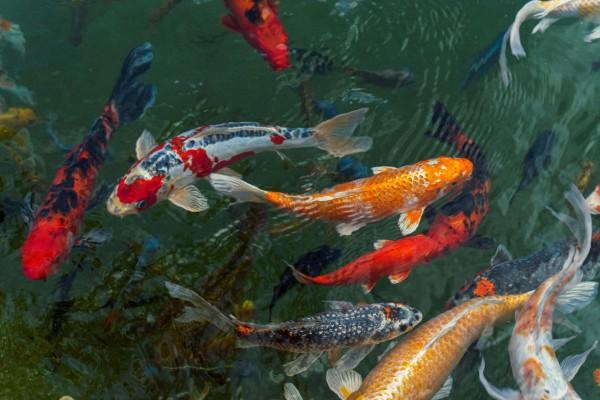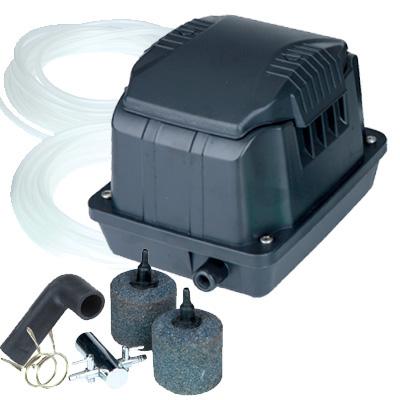Koi Ponds

Here at Pondkeeper we get many questions about building koi ponds, koi filtration and koi maintenance. We have put together a list of the most frequently asked questions with answers from our team who have years of experience!
How deep should my koi pond be?
It is highly advised to make your koi pond at least 1.2m (4ft) deep over 40% of the surface area. The greater depth means the temperature is more stable and gives your fish an appropriate depth to hide in should predators make a visit.
Although it’s incredibly tempting to save on costs by building a smaller pond, doing so may put you in the position of having to build additional ponds to house your growing collection in the future. Most enthusiasts who start off small end up building more ponds later (or extending their current pond) and therefore spending more in the long run. You’re better off starting with a pond that seems larger than necessary at first, as this ensures your koi will have room to grow even if you add more at a later date.
How many koi can I keep in my pond?
The exact stocking levels will vary greatly depending on the equipment you’re using, frequency of water changes, food given and amount of koi. The general rule of thumb is that you can keep 1KG of koi per 1000L of water. On average, 2.5cm (1”) of fish will weigh 30g. Keeping to these levels should enable good water quality to be easily maintained provided appropriate filtration is installed.

Koi are much dirtier than goldfish and so require a higher level of filtration to keep the water clean and prevent imbalances in the pond. You need to be filtering the full volume of your pond once an hour, so your 10,000L koi pond will need a 10,000LPH pump in it. We have a range of Koi Filters to suit almost all pond sizes.
You really want to be steering clear of pressurised filters as they do not offer the high level of filtration required to keep the koi pond clean. That being said, the Hozelock Bioforce Revolution is suitable to use if your pond is less than 8000L.
You should never be using an All-In-One pump in a koi pond, they do not remove enough waste and can cause high levels of ammonia. This ammonia is toxic and, if left unchecked, can kill both plants and animals in the pond.
It’s always a good idea to get a bigger filtration system that you think is necessary so that it will still be suitable once your fish have grown.
It is important to give your filter time to mature and develop a healthy culture of bacteria in the biological stage, this can take five to six weeks. During this period you should only have a small amount of fish in your pond. Some people choose to keep a few goldfish as this point while the filter matures, then begin to add Koi slowly later on. Some people chose to bypass this maturation period by using Evolution Aqua Filter Start Gel.

A plentiful supply of oxygen is vital in any pond and so an air pump is always advisable. Both your fish and the biological stage of your filter require a good supply of oxygen to thrive. It is a good idea to place a few air stones directly into the filter system to provide oxygen for the filter bacteria as well as in the pond itself. You can't have too much oxygen going into the pond so choose the largest one your budget will allow.
Is it OK to keep goldfish in my koi pond?
Yes! Goldfish and Shubunkins will live happily in koi ponds. Certain fish such as Rudd and Orfe are more sensitive to certain medications so always make sure you check any treatments before use.
.jpg)
You can if they will let you! Koi tend to demolish or eat any plants so most koi keepers do not have any vegetation in the pond. Lilies grown in large and heavy baskets can occasionally work well as the baskets are too weighty for the koi to overturn. Marginal plants can also be OK provided they are in an area too shallow for the koi to enter.
Should I be testing the water?
It is vital to regularly test the water of your koi pond. This will ensure any spikes are caught and remedied as early as possible, preventing disease and even death.
The most popular test kit is the Blagdon Pond Health Test Kit although the Tetra 6-in-1 test kit is excellent value for money.
You can use these readings to ensure that your biological filtration system is working properly. A sudden change in nitrate levels can be indicative of a problem in the pond. Each species of fish and some plants will have certain pH requirements. You can purchase additives to modify the pH of the water to make it compatible with the needs of the pond inhabitants:.jpg)
• pH Adjuster for Alkaline Ponds
The first steps to take if a problem is detected is to undertake a partial water change (this should be no more than 30% in one go to avoid stressing the fish). You should also stop feeding whilst investigating to ensure no more waste is added to the pond. Common causes for water imbalances include; overfeeding; too many fish; an unmaintained filter and stocking the pond too quickly whilst the filter is still maturing.
A properly planned and designed pond will provide countless hours of enjoyment. In addition, a little time spent in planning and preparation will save hours of maintenance and will help prevent many of the common problems that plague less-experienced pond owners. So, do your homework now and you will be enjoying a beautiful and healthy pond or water garden in no time.
If you have any queries, please email us on info@pondkeeper.co.uk.